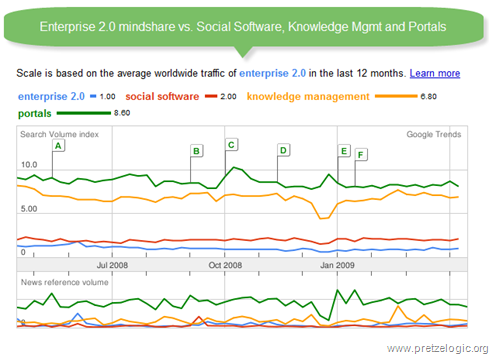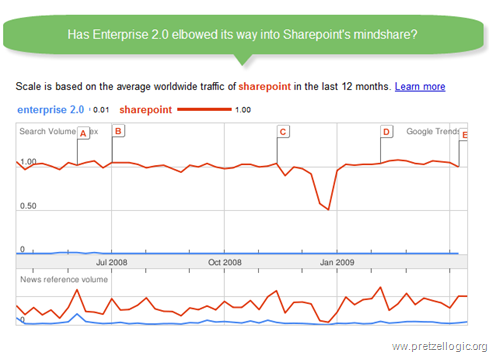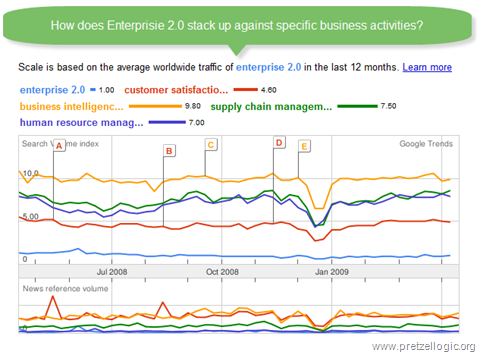Enterprise 2.0 marketing score card: solid ‘C’
Google Trends is one tool that I put to work fairly often in my consulting work. Last week I decided to benchmark some of the concepts we hear a lot about in the area of Enterprise 2.0 (KM, Portals, SharePoint) and others that we should be paying attention to (business activities such as Lead Generation, HR, Supply Chain Management, etc). The idea was to see how current Enterprise 2.0 search traffic and news volume fares against these concepts.
Search phrases are subject to human interpretation and Google’s magic algorithms. However, Google’s advertising business is built on the premise that search is a very good measure of current interest and intent. And I’m piggybacking on that in the analysis below.
What I found wasn’t flattering, to say the least. Here goes:
1. The mindshare is steadily fixed on older incarnations of communication and collaborative mediums
- If KM and portals are what we, in the social computing arena, consider to be older, inefficient communication and collaboration mechanisms, well, that’s still where the attention firmly sits.
2. Enterprise 2.0 nemesis, a.k.a Microsoft SharePoint, continues to dominate mindshare
For good or bad, a good number of Enterprise 2.0 vendors are focused on obliterating SharePoint. So have they been successful in making a dent in the current mindshare commanded by SharePoint?
- Not the case. I wasn’t expecting to see E2.0 having caught up with SharePoint, but since the 2006 coining of the term by Stuart Eccles, and subsequent evangelism by then Harvard Business School Professor Andrew MacAfee, you would have expected at least the start of an upward trend.
3. Business activities have at least 5 times more mindshare when compared to Enterprise 2.0
Finally, in line with most posts on this blog, I went a step further to see how Enterprise 2.0 compares against a representative set of business activities and pain points, faced by most organizations. I wasn’t expecting a break through here to be honest, rather I wanted to see how far away the E2.0 mindshare really was relative to business activity:
- Customer Satisfaction, the closet in terms of search volume was still approximately 5 times more popular when compared to Enterprise 2.0; Business intelligence is the furthest away.
Some thoughts on why this is the case and where we need to go from here….
Enterprise 2.0 is plagued by tactical value propositions
The focus needs to move away from replacing email and document sharing to say, competing more effectively by better serving partners and customers. Or shrinking the distance between sales and prospects. Or accelerating product innovation by extending a hand to your supply chain. And on and on.
Over on the FastForward blog, Jevon MacDonald wrote a great post on understanding and defining Enterprise 2.0, IMO, correctly stating that we need to differentiate between Social Strategy and Social Software. Jevon is spot on when he says that there’s a need for a more strategic framework to institutionalize socially enabled business processes.
At a more tactical level, positioning internal Enterprise 2.0 solutions as more efficient incarnations of general purpose Intranets may not be an effective approach for internal champions to sell social software to executives. In my experience, general purpose Portals/Intranets, often E2.0 predecessors, have in fact not been that silver bullet in the enterprise that was meant to remedy information overload, fragmented data access or inefficient communication. That’s partly due to them being general in purpose and lacking in activity focus.
SharePoint is easy to sell
Setting SharePoint as a target is again merely a tactical step to transforming an organization. However since so many vendors are focused on this, it bares discussion.
Sometimes I wonder if it‘s precisely the structured process put forth by SharePoint that actually made it easy to define and sell, up the food chain. After buying into multi million dollar ERP systems that strictly enforced workflow and control, structured ERP might be the perfect trampoline to justify structured SharePoint. SharePoint becomes the process-enforced file management and document sharing system across the enterprise to compliment process centric finance, HR, inventory management and the other 20 ERP-driven business activities.
For more color on this topic, follow this great discussion thread about SharePoint / Enterprise 2.0 recently, by the likes of Mike Gotta, Michael Sampson, Todd Stephens, Oliver Marks, Dion Hinchcliffe and James Dellow.
Lack of/minimal association with pain points
As I’ve previously written, too much of the Enterprise 2.0 talk takes place in a vacuum. I wish more solutions were aimed at fixing focused inefficiencies in business activity, brought about by those very ERP systems.
We need to stop patting ourselves on the back for small isolated gains that were never intended to go big and remove the high viscosity that plagues many business processes today. I’m an advocate of starting small (depending on the circumstances) for proof of concept purposes but small absolutely should not mean insignificant. Start with a very important use case where the pain is high and the benefits can be huge (a large account, a flagship product, whatever) and then scale out. Too often, starting small is equated with starting where it doesn’t matter.
We, the bloggers…
I’m looking in the mirror as well when I rate Enterprise 2.0 marketing. I share the stage with plenty of other bloggers and consultants who diligently opine on the subject of Enterprise 2.0. Yet, there’s a clear need to provide additional torque to effectively raise awareness to the level it deserves. My personal belief is that this can be done by celebrating institutionalized success but also by setting a higher bar and calling out timid implementations that won’t really move the needle.
There’s plenty of visionary speak going on at the 100 thousand foot level. Most recently, Cisco CTO, Padmasree Warrior (on Twitter) wrote an inspiring post predicting amongst other things, that ‘Collaboration Networks’ will be to the Enterprise, what Social Networks are to consumers. Other terms such as ‘Social Business’ and ‘Social Business Software’ are often used to describe the new design of organizational behavior. These concepts are pertinent to board room and executive level introductions but very little is said about how to change the organizational DNA to make this happen. To be clear, I believe these visionary benchmarks are extremely important to ignite wholesale change and I’m even currently involved in such discussions with senior executives at very large organizations. But more guidance needs to be provided to managers who will take the necessary steps to institutionalize this change. That’s where strategic case studies will emerge to fuel the news cycle.
I’m looking forward to discussing this at the Enterprise 2.0 conference in Boston this summer and really talking execution, which is my focus. By execution I don’t mean only how to drive adoption for a wiki or employee social network. I mean how to also change organizational behavior to capitalize on an Enterprise 2.0 design which may well include wikis, micro-messaging tools, etc.
I’ve seen over and over again that smart business leaders who give you the time to discuss a bolder better strategy, will want to hear about how it can be successfully executed. So we need to be ready to address that from the get go.
Related articles by Zemanta



![Reblog this post [with Zemanta]](http://img.zemanta.com/reblog_e.png?x-id=f2cccc8a-efe7-44c4-b6c5-d889b1f76737)